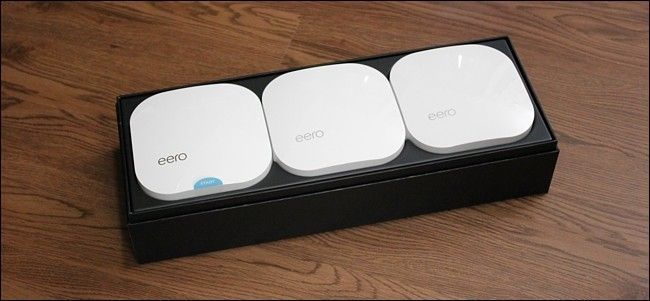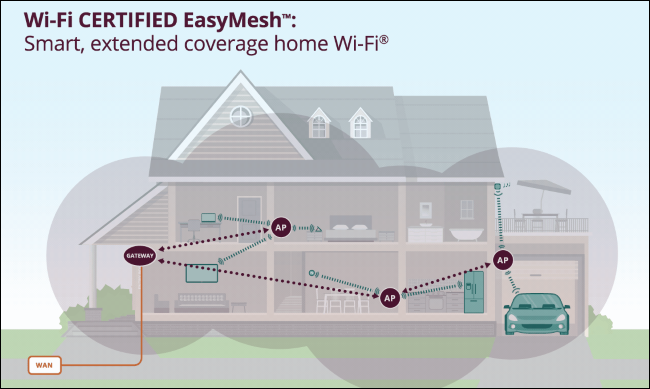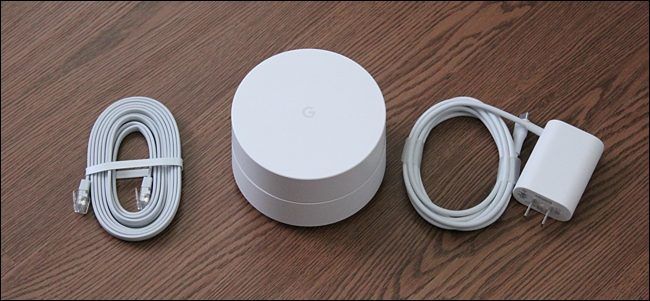Quick Links
Mesh Wi-Fi systems offer solid Wi-Fi coverage throughout large areas that a single router can't cover. But every manufacturer has its own mesh Wi-Fi system, and they can't communicate with each other. That's where the new "Wi-Fi EasyMesh" standard comes in.
Don't get too excited, though. No manufacturers have actually signed on to use this standard yet. Eero, Google, Linksys, Netgear, and D-Link all like their own proprietary systems.
What is Mesh Wi-Fi?
A standard Wi-Fi router has only a limited range. If you have a large home or business, or if you want to extend your Wi-Fi outside, you need additional pieces of hardware. Traditionally, people used Wi-Fi extenders for this. But Wi-Fi extenders can be a bit complicated to set up, and they sometimes require creating new Wi-Fi network names, known as SSIDs, for the extended network. Yes, you can do that by configuring your various access points to use the same SSID (if they allow you to), but it doesn't always work well.
Mesh Wi-Fi systems are similar to using a router and one or more Wi-Fi extenders, but they're easier to set up. All you have to do is plug in several of the mesh Wi-Fi units throughout the area and go through a few quick steps in the accompanying smartphone app. The mesh Wi-Fi devices create a Wi-Fi network and communicate with each other. You'll appear to have a single Wi-Fi network with a single name, but devices automatically connect to the best access point. If you need to extend your Wi-Fi network even further, just buy another mesh Wi-Fi unit from the same manufacturer and join it to your mesh network.
In other words, mesh Wi-Fi systems offer a much simpler way to set up a Wi-Fi network that would normally require multiple wireless routers, or a wireless router and one or more Wi-Fi extenders.
You Have to Get All Your Mesh Wi-Fi Hardware From One Company
There are many different mesh Wi-Fi systems from different manufacturers, including the Eero, Google WiFi, Linksys VELOP, Netgear Orbi, and D-link Covr.
But each manufacturer has its own proprietary mesh Wi-FI standard, and they're not compatible. If you already have an Eero mesh Wi-Fi system, you can't buy a Google Wi-Fi or Linksys VELOP unit and connect it to your Eero mesh network. You have to buy another Eero unit. Different mesh Wi-Fi systems can't communicate with each other and be part of the same mesh Wi-Fi network. If you have a Linksys VELOP mesh Wi-Fi network and you buy some Netgear Orbi units, you now have two separate mesh Wi-Fi networks.
In other words, once you've bought into one mesh Wi-Fi system, you're stuck buying new access points from that manufacturer---unless you want to get rid of all your existing mesh Wi-Fi hardware and start over.
"Wi-Fi Certified EasyMesh" Makes Mesh Hardware Interoperable
The Wi-Fi Alliance---that's the industry group that defines Wi-Fi standards like WPA3 and 802.11ac---doesn't like this. After all, Wi-Fi itself is an industry standard that allows devices from different manufacturers to communicate with each other. You can assemble a home network of devices from many different manufacturers.
The "Wi-Fi Certified EasyMesh" standard is designed to bring that interoperability to mesh Wi-Fi hardware. One of the mesh Wi-Fi devices functions as a "WiFi EasyMesh controller," and the others serve as "Wi-Fi EasyMesh agents." So, if Google and Linksys both embraced this standard, you could buy a Linksys VELOP unit and connect to your existing Google WiFi network, for example.
What's the advantage here? Well, competition, for one. You'd no longer be stuck buying all your hardware from one company, which could lower prices for mesh Wi-Fi units. As the Wi-Fi Alliance's Kevin Robinson put it in an interview with PCWorld, "a standardized approach enables great economies of scale."
Robinson went on to say that manufacturers will still be able to differentiate their products---at the controller level. So, if you have a Google WiFi device functioning as your controller, Google's software running on the controller can manage and configure your network however it likes. All those "smarts" would work with mesh Wi-Fi units from other manufacturers that are connected to the network as "agents." The "agents" would behave in a standardized fashion, so they'd work with a controller from any manufacturer.
No Manufacturers Are Supporting EasyMesh Yet
Unfortunately, no manufacturers have yet announced plans to support this standard. The Wi-Fi Alliance announced this standard without any manufacturers saying they'll implement it. So, while the standard is out there, there's no indication the hardware ever will be.
Sure, the Wi-Fi Alliance's press release includes a variety of supportive quotes from chipset makers like Intel, Broadcom, Marvell, MediaTek, and Qualcomm. That could leave you to believe the industry is on board---but none of these companies actually makes mesh Wi-Fi systems. The companies making mesh Wi-Fi hardware are all notably absent.
Manufacturers haven't said much publicly. An Eero support person said "Can't say for now whether we'll integrate the proposed EasyMesh standard, but we appreciate your interest" on Twitter, but that's it. We couldn't find any public comments from other mesh Wi-Fi companies yet.
Why Isn't Anyone Supporting It?
The Wi-Fi Alliance says this standard "removes the need to stay within a single-vendor ecosystem." But those vendors want you to stay within their ecosystem. It's good for their bottom line if you're forced to buy their mesh Wi-Fi hardware without any competition.
Of course, some manufacturers may not like the standard for other reasons. For example, Eero said that its "proprietary mesh called TrueMesh... allows us to continually improve & optimize performance with iterations at our own pace."
In other words, Eero might argue that EasyMesh is a "lowest common denominator" standard, and that they can better optimize the mesh network, implement more advanced features, and ensure all access points are up-to-date with the latest security updates if they can control every piece of mesh hardware.
For now, despite the new standard, there's no indication that mesh Wi-Fi units will become interoperable any time soon. But the standard is out there, and new companies may decide to jump in and create products based on it in the future.
Image Source: Wi-Fi Alliance



